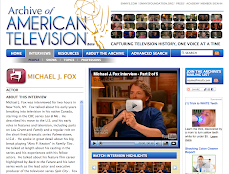
Yes, tonight is Conan O'Brien's Tonight Show debut, but lest we forget Andy Richter will be joining him as the show's announcer/comedy-bit contributor. Although NBC has eschewed the word sidekick in their press announcement, Richter's previous Late Night tenure was certainly reminiscent of Ed McMahon's Tonight Show role of faithful sidekick. On his start with The Tonight Show, the Archive offers advice to Andy from our interview with Ed in 2002.

On his role as the sidekick of "The Tonight Show":
That role, the way I was able to do it, in my mind, I loved it. And second bananas go back to Greek Drama, way back to the golden age of Greece, they had second bananas, the friend of the boss, throwing little jabs in, you know. Having a counterpoint, something different and that was my role and [Carson] let me do it and it was wonderful.
On not overstepping his bounds:
Oftentimes I see shows where the guy intrudes, but he shouldn’t have intruded. You know my attitude about being the second banana was to be in when needed and out of the way when not needed. And that’s an art form.
On the "art form" in action:
Johnny always had a cigarette lighter on his desk. And he’s doing a piece of material, [off] a sheet of paper, and he’s doing jokes, and he goes down the first page and [it's] very mild, it’s not clicking at all. The second page, about the second joke, it’s really not working. The audience is not buying it, and it’s not funny. Very bravely— I have to be brave, cause he may have the biggest joke in the world later on— I pick up the cigarette lighter, I light it... and here’s the boss doing a piece of comedy material that eight writers have written, and he may have a lot of stuff in here that he can’t wait to get to and its dying, but I take a chance, and he holds it [over] and lets it burn, just lets it burn. And the audience is going crazy, they’re dying. And he looks at me, and he reaches over, he picks up the wastepaper basket and very gingerly, now it’s really on fire, he lifts up the top of the wastepaper basket, and just as he does, Doc Severinson on the trumpet plays "Taps." Now eight writers in a room for a week wouldn’t come up with that bit, that just happened, but that’s how you feel each other, how you know. The bit is dying, there’s no place to go, how do you solve it? Again me nailing the boss, you know.... so the audience loved that.
On how he and Carson kept their working relationship spontaneous:
I would meet Johnny before the show in his dressing room for about 7 minutes. We would never, ever talk about the show. We’d talk about anything else, you know, currently [now in 2002, it would be] will the Pope retire in Poland and will there be a replacement? And he’d have something funny to say about that. There’d be something funny, you know, maybe they’ll move the Vatican to Warsaw, it’ll look nice in Warsaw, you know. It rains a lot, but, you know it’d be a joke or something. That’s what we would do before the show. Never, ever, you do this, I’ll do that, I’m going to say this...
On Carson's use of McMahon to see how the show was going:
Johnny would do his monologue and do the golf swing and we’d go to the commercial and then I would be standing at the mike you know, watching him, him watching me, you know he would also like play to me to see how it was going, you know I was his thermometer. You know, is this going good? You know, he’d look over at me.
On Johnny Carson's acceptance of McMahon's role:
We never discussed it. There was never any complements, there was never any criticism. He never said you’re doing a good job, he never said you’re doing something I don’t like. In 30 years, that never came up.
On his trademark introduction of Carson:
The first time I introduced him I came up with that gimmick of the "heeeeere’s" elongating the here’s, I thought of that that afternoon. That day October 1st 1962, I thought of it, and nobody told me to do it, I didn’t ask anybody's permission, I just didn’t feel like saying "Here’s Johnny Carson"— didn’t seem like enough for me. It should be bigger than that, it should be more explosive, more expansive, more lights, more fireworks. So I came up with the idea of expanding "here’s," and I knew I was right cause the next morning, when I got to work, when I came in, everybody I met was saying, "heeeeere’s Johnny," because they knew we had scored, you know, it’d been a hit, and everybody on the staff, everybody in the hall, you know, the pages all the people that you’d run into walking through NBC in New York, were repeating it, I said I know I got something. So I kept doing it, no one told me to stop.
Here's a link to Ed McMahon's entire 8-part Archive interview.
 Gale Storm became America's sweetheart, playing free-spirited "Margie Albright" on the sitcom My Little Margie, forever trying to keep her widowed father (Charles Farrell) out of (romantic) troubles. She followed up this series playing social director "Susanna Pomeroy" of the "S. S. Ocean Queen" on The Gale Storm Show aka Oh, Susanna.
Gale Storm became America's sweetheart, playing free-spirited "Margie Albright" on the sitcom My Little Margie, forever trying to keep her widowed father (Charles Farrell) out of (romantic) troubles. She followed up this series playing social director "Susanna Pomeroy" of the "S. S. Ocean Queen" on The Gale Storm Show aka Oh, Susanna. 













